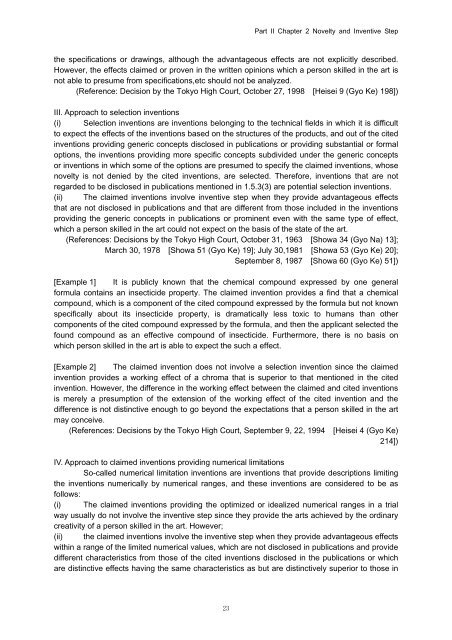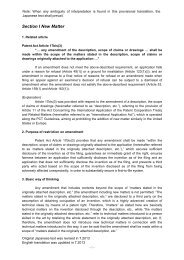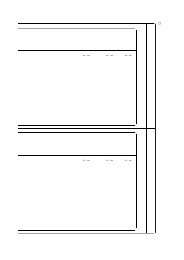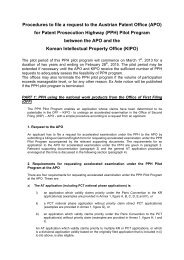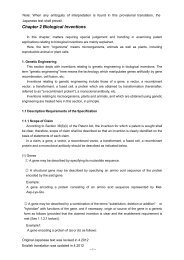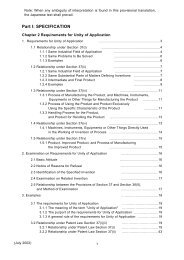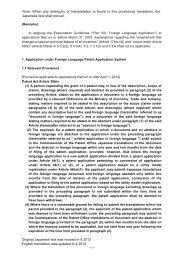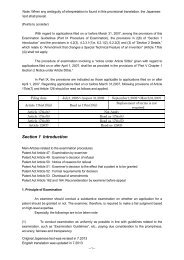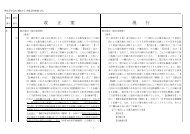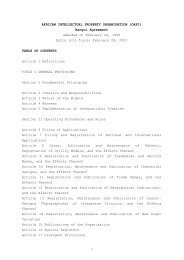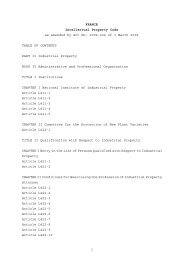Chapter 2 Novelty and Inventive Step - Japan Patent Office
Chapter 2 Novelty and Inventive Step - Japan Patent Office
Chapter 2 Novelty and Inventive Step - Japan Patent Office
You also want an ePaper? Increase the reach of your titles
YUMPU automatically turns print PDFs into web optimized ePapers that Google loves.
Part II <strong>Chapter</strong> 2 <strong>Novelty</strong> <strong>and</strong> <strong>Inventive</strong> <strong>Step</strong><br />
the specifications or drawings, although the advantageous effects are not explicitly described.<br />
However, the effects claimed or proven in the written opinions which a person skilled in the art is<br />
not able to presume from specifications,etc should not be analyzed.<br />
(Reference: Decision by the Tokyo High Court, October 27, 1998 [Heisei 9 (Gyo Ke) 198])<br />
III. Approach to selection inventions<br />
(i) Selection inventions are inventions belonging to the technical fields in which it is difficult<br />
to expect the effects of the inventions based on the structures of the products, <strong>and</strong> out of the cited<br />
inventions providing generic concepts disclosed in publications or providing substantial or formal<br />
options, the inventions providing more specific concepts subdivided under the generic concepts<br />
or inventions in which some of the options are presumed to specify the claimed inventions, whose<br />
novelty is not denied by the cited inventions, are selected. Therefore, inventions that are not<br />
regarded to be disclosed in publications mentioned in 1.5.3(3) are potential selection inventions.<br />
(ii) The claimed inventions involve inventive step when they provide advantageous effects<br />
that are not disclosed in publications <strong>and</strong> that are different from those included in the inventions<br />
providing the generic concepts in publications or prominent even with the same type of effect,<br />
which a person skilled in the art could not expect on the basis of the state of the art.<br />
(References: Decisions by the Tokyo High Court, October 31, 1963 [Showa 34 (Gyo Na) 13];<br />
March 30, 1978 [Showa 51 (Gyo Ke) 19]; July 30,1981 [Showa 53 (Gyo Ke) 20];<br />
September 8, 1987 [Showa 60 (Gyo Ke) 51])<br />
[Example 1] It is publicly known that the chemical compound expressed by one general<br />
formula contains an insecticide property. The claimed invention provides a find that a chemical<br />
compound, which is a component of the cited compound expressed by the formula but not known<br />
specifically about its insecticide property, is dramatically less toxic to humans than other<br />
components of the cited compound expressed by the formula, <strong>and</strong> then the applicant selected the<br />
found compound as an effective compound of insecticide. Furthermore, there is no basis on<br />
which person skilled in the art is able to expect the such a effect.<br />
[Example 2] The claimed invention does not involve a selection invention since the claimed<br />
invention provides a working effect of a chroma that is superior to that mentioned in the cited<br />
invention. However, the difference in the working effect between the claimed <strong>and</strong> cited inventions<br />
is merely a presumption of the extension of the working effect of the cited invention <strong>and</strong> the<br />
difference is not distinctive enough to go beyond the expectations that a person skilled in the art<br />
may conceive.<br />
(References: Decisions by the Tokyo High Court, September 9, 22, 1994 [Heisei 4 (Gyo Ke)<br />
214])<br />
IV. Approach to claimed inventions providing numerical limitations<br />
So-called numerical limitation inventions are inventions that provide descriptions limiting<br />
the inventions numerically by numerical ranges, <strong>and</strong> these inventions are considered to be as<br />
follows:<br />
(i) The claimed inventions providing the optimized or idealized numerical ranges in a trial<br />
way usually do not involve the inventive step since they provide the arts achieved by the ordinary<br />
creativity of a person skilled in the art. However;<br />
(ii) the claimed inventions involve the inventive step when they provide advantageous effects<br />
within a range of the limited numerical values, which are not disclosed in publications <strong>and</strong> provide<br />
different characteristics from those of the cited inventions disclosed in the publications or which<br />
are distinctive effects having the same characteristics as but are distinctively superior to those in<br />
23


